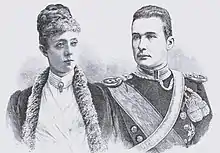Albrecht, Duke of Württemberg
Albrecht, Duke and Crown Prince of Württemberg (Albrecht Maria Alexander Philipp Joseph; 23 December 1865 – 31 October 1939) was the last heir presumptive to the Kingdom of Württemberg, a German military commander of World War I, and the head of the House of Württemberg from 1921 to his death.
| Albrecht | |||||
|---|---|---|---|---|---|
| Crown Prince of Württemberg | |||||
 Duke Albrecht c. 1905 | |||||
| Head of the House of Württemberg | |||||
| Tenure | 2 October 1921 - 31 October 1939 | ||||
| Predecessor | King Wilhelm II | ||||
| Successor | Duke Philipp Albrecht | ||||
| Born | 23 December 1865 Vienna, Empire of Austria | ||||
| Died | 31 October 1939 (aged 73) Altshausen, State of Württemberg, Nazi Germany | ||||
| Spouse | |||||
| Issue | See
| ||||
| |||||
| House | Württemberg | ||||
| Father | Duke Philipp of Württemberg | ||||
| Mother | Archduchess Maria Theresa of Austria | ||||
| Religion | Roman Catholic | ||||
| Military career | |||||
| Allegiance | |||||
| Service/ | |||||
| Years of service | 1885–1919 | ||||
| Rank | General field marshal | ||||
| Commands held | German 4th Army (1914–1917) Army Group Albrecht (1917–1918) | ||||
| Battles | First World War | ||||
Early life
Duke Albrecht was born in Vienna as the eldest child of Duke Philipp of Württemberg and his wife Archduchess Maria Theresa of Austria, daughter of Archduke Albert, Duke of Teschen.[1]
Albrecht entered the armies of the Kingdom of Württemberg and the German Empire in 1883, rose quickly through its ranks, and became the heir apparent to the throne of Württemberg.[1]
In 1910, Albrecht attended the funeral of Edward VII.[2][3] He was a third cousin of Mary of Teck, who was the Queen consort of George V.
World War I
When World War I began, Duke Albrecht's VI Inspectorate Corps was formed into the 4th Army,[4] 123 battalions strong. As King William II had no sons, Albrecht was appointed the army's commander and assigned to the Ardennes, with Walther von Lüttwitz serving as his chief of staff. This army he led to victory alongside Crown Prince Wilhelm's 5th Army at the Battle of the Ardennes in August 1914. Following that victory, the 4th Army saw action in the First Battle of the Marne before being transferred to Flanders in October, where Albrecht commanded them during the Battle of the Yser. Albrecht also commanded the German forces during the Second Battle of Ypres, where poison gas was used on a large scale for the first time.[5]
Albrecht was awarded the Pour le Mérite in August 1915 and promoted to Generalfeldmarschall in August 1916. The new Army Group Duke Albrecht was placed under his command in February 1917, and he was responsible for the southern sector of the Western Front until the Armistice.
Postwar
Albrecht had become heir presumptive to the Kingdom of Württemberg following the death of his father in October 1917, but the German Empire's World War I defeat and the abdication of his cousin King Willhelm II of Württemberg following the German Revolution prevented him from ever succeeding to the throne. He became head of the House of Württemberg after the death of Wilhelm on October 2, 1921.
Albrecht died at Altshausen Castle. His son Duke Philipp Albrecht succeeded him as head of the House of Württemberg.
Family

Albrecht was married in Vienna on 24 January 1893 to Archduchess Margarete Sophie of Austria,[6] a daughter of Archduke Carl Ludwig. They had seven children:
- Philipp Albrecht, Duke of Württemberg (1893–1975).
- Duke Albrecht Eugen of Württemberg (born 8 January 1895 in Stuttgart; died 24 June 1954 in Schwäbisch Gmünd), who married Princess Nadezhda of Bulgaria (1899–1958), daughter of Tsar Ferdinand I. They had five children.
- Duke Carl Alexander of Württemberg (born 12 March 1896 in Stuttgart; died 27 December 1964 in Altshausen), a Benedictine monk known as "Father Odo".
- Duchess Maria Amalia of Württemberg (born 15 August 1897 in Gmunden; died 13 August 1923 in Altshausen), briefly engaged to Crown Prince George of Saxony.
- Duchess Maria Theresa of Württemberg (born 16 August 1898 in Stuttgart; died 26 March 1928 in Eibingen).
- Duchess Maria Elisabeth of Württemberg (born 12 September 1899 in Potsdam; died 15 April 1900 in Meran).
- Duchess Margarita Maria of Württemberg (born 4 January 1902 in Stuttgart; died 22 April 1945 in Altshausen).
Decorations and awards
 Württemberg:[7]
Württemberg:[7]

.svg.png.webp) Austria-Hungary:
Austria-Hungary:
- Grand Cross of the Royal Hungarian Order of St. Stephen, 1891[9]
- Knight of the Golden Fleece, 1893[10]
.svg.png.webp) Baden: Knight of the House Order of Fidelity, 1904[11]
Baden: Knight of the House Order of Fidelity, 1904[11].svg.png.webp) Kingdom of Bavaria:
Kingdom of Bavaria:
- Knight of St. Hubert, 1886[12]
- Knight of the Military Order of Max Joseph
 Monaco: Grand Cross of St. Charles, 12 February 1889[13]
Monaco: Grand Cross of St. Charles, 12 February 1889[13] Grand Duchy of Hesse: Grand Cross of the Ludwig Order, 7 September 1899[14]
Grand Duchy of Hesse: Grand Cross of the Ludwig Order, 7 September 1899[14] Lippe: Cross of Honour of the House Order of Lippe, 1st Class[7]
Lippe: Cross of Honour of the House Order of Lippe, 1st Class[7] Mecklenburg-Schwerin: Military Merit Cross, 1st Class, 1914
Mecklenburg-Schwerin: Military Merit Cross, 1st Class, 1914 Oldenburg: Grand Cross of Honour of the Order of Duke Peter Friedrich Ludwig, with Golden Crown and Collar[7]
Oldenburg: Grand Cross of Honour of the Order of Duke Peter Friedrich Ludwig, with Golden Crown and Collar[7] Schwarzburg: Princely Schwarzburg Cross of Honour, 1st Class with Crown[7]
Schwarzburg: Princely Schwarzburg Cross of Honour, 1st Class with Crown[7] United Kingdom: Honorary Knight Grand Cross of the Royal Victorian Order, 14 August 1907[15]
United Kingdom: Honorary Knight Grand Cross of the Royal Victorian Order, 14 August 1907[15].svg.png.webp) Principality of Waldeck and Pyrmont: Cross of Merit, 1st Class[7]
Principality of Waldeck and Pyrmont: Cross of Merit, 1st Class[7] Persian Empire: Order of the Lion and the Sun, 1st Class[7]
Persian Empire: Order of the Lion and the Sun, 1st Class[7].svg.png.webp) Kingdom of Prussia:[7]
Kingdom of Prussia:[7]
- Knight of the Black Eagle, with Collar, 18 January 1900[16]
- Grand Cross of the Red Eagle, 18 January 1900
- Pour le Mérite (military), 22 August 1915;[8] with Oak Leaves, 25 February 1918[1]
 Hohenzollern: Cross of Honour of the Princely House Order of Hohenzollern, 1st Class[7]
Hohenzollern: Cross of Honour of the Princely House Order of Hohenzollern, 1st Class[7].svg.png.webp) Kingdom of Saxony: Knight of the Rue Crown, 1894[17]
Kingdom of Saxony: Knight of the Rue Crown, 1894[17]
Ancestry
Notes
- Pawly 2003, p. 30.
- Tuchman 2014, p. 16.
- Hopkins 1910, p. 372.
- Pawly 2003, p. 11.
- Zabecki 2014, p. 1504.
- born 13 May 1870 in Artstetten Castle; died 24 August 1902 in Gmunden.
- Hof- und Staats-Handbuch des Königreich Württemberg (1908), "Departement des Kriegswesen" p. 216
- "Albrecht Maria Alexander Philipp Joseph Herzog von Württemberg". the Prussian Machine. Archived from the original on 23 October 2017. Retrieved 10 September 2020.
- "A Szent István Rend tagjai" Archived 22 December 2010 at the Wayback Machine
- Boettger, T. F. "Chevaliers de la Toisón d'Or – Knights of the Golden Fleece". La Confrérie Amicale. Archived from the original on 7 August 2018. Retrieved 25 June 2019.
- Hof- und Staats-Handbuch des Großherzogtum Baden (1910), "Großherzogliche Orden" p. 41
- Hof- und Staats-Handbuch des Königreich Bayern (1908), "Königliche Orden" p. 9
- Sovereign Ordonnance of 12 February 1889
- "Ludewigs-orden", Großherzoglich Hessische Ordensliste (in German), Darmstadt: Staatsverlag, 1914, p. 6 – via hathitrust.org
- The London Gazette, issue 28058, p. 6149
- "Court Circular". The Times. No. 36043. London. 19 January 1900. p. 7.
- Sachsen (1901). "Königlich Orden". Staatshandbuch für den Königreich Sachsen: 1901. Dresden: Heinrich. p. 4 – via hathitrust.org.
References
- Hopkins, J. Castell (1910). The Life of King Edward VII with a Sketch of the Career of King George V. W.E. Scull.
- Pawly, Ronald (2003). The Kaiser's Warlords: German Commanders of World War I. Illustrated by Patrice Courcelle. Osprey. ISBN 978-1-78096-673-1.
- Tuchman, Barbara W. (2014) [1962]. Guns of August. Random House Trade. ISBN 978-0-345-38623-6.
- Zabecki, David T. (28 October 2014). Germany at War: 400 Years of Military History. ABC-CLIO. ISBN 978-1598849813.
